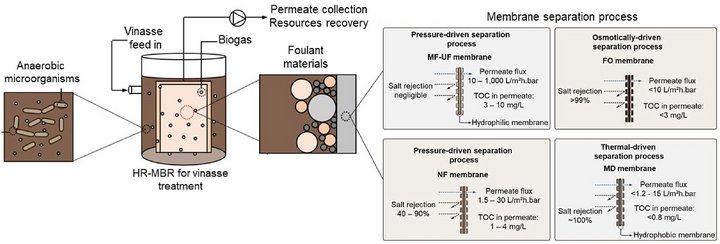Ethanol production has increased over the years, and Brazil ranking second in the world using sugarcane as the main raw material. However, 10–15 L of vinasse are generated per liter of ethanol produced. Besides large volumes, this wastewater has high polluting potential due to its low pH and high concentrations of organic matter and nutrients. Given the high biodegradability of the organic matter, the treatment of this effluent by anaerobic digestion and membrane separation processes results in the generation of high value-added byproducts such as volatile fatty acids (VFAs), biohydrogen and biogas. Membrane bioreactors have been widely evaluated due to the high efficiency achieved in vinasse treatment. In recent years, high retention membrane bioreactors, in which high retention membranes (nanofiltration, reverse osmosis, forward osmosis and membrane distillation) are combined with biological processes, have gained increasing attention. This paper presents a critical review focused on high retention membrane bioreactors and the challenges associated with the proposed configurations. For nanofiltration membrane bioreactor (NF-MBR), the main drawback is the higher fouling propensity due to the hydraulic driving force. Nonetheless, the development of membranes with high permeability and anti-fouling properties is uprising. Regarding osmotic membrane bioreactor (OMBR), special attention is needed for the selection of a proper draw solution, which desirably should be low cost, have high osmolality, reduce reverse salt flux, and can be easily reconcentrated. Membrane distillation bioreactor (MDBR) also exhibit some shortcomings, with emphasis on energy demand, that can be solved with the use of low-grade and residual heat, or renewable energies. Among the configurations, MDBR seems to be more advantageous for sugarcane vinasse treatment due to the lower energy consumption provided by the use of waste heat from the effluent, and due to the VFAs recovery, which has high added value.
Zum Inhalt springen
Menü
- de
- en
Google Custom Search
Wir verwenden Google für unsere Suche. Mit Klick auf „Suche aktivieren“ aktivieren Sie das Suchfeld und akzeptieren die Nutzungsbedingungen.
